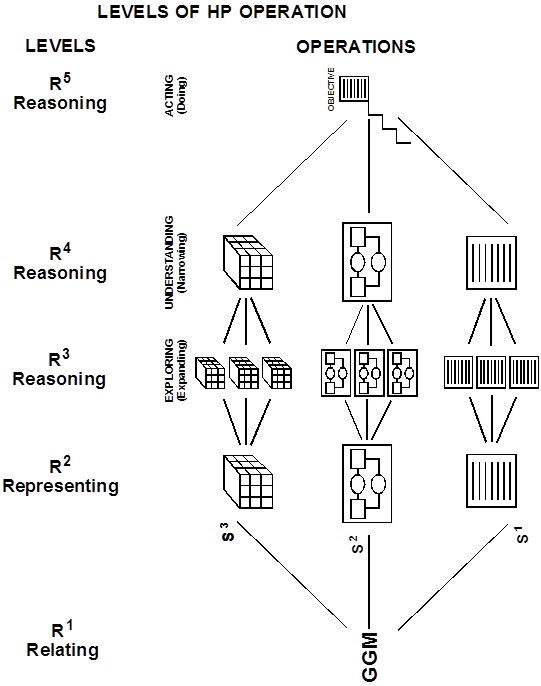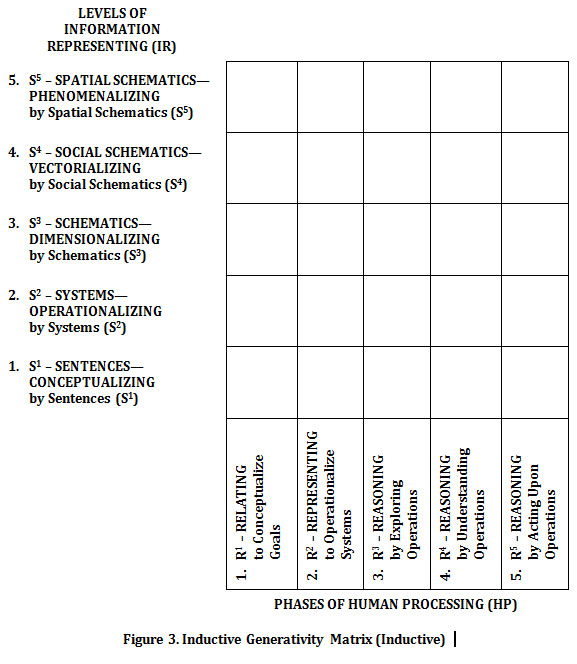Generativity
As may be viewed in the animation, Generativity is “thinking beyond the high-beams.” It is as if we were driving along as we use our brainpower in most of our lives—using our low-beams. Once in a while at night, we switch to high-beams and see things that we would never have otherwise seen. This enables us to avoid accidents with the obstacles lying ahead of us.
When we flick on our “thinking beams,” we see beyond the high-beams. This empowers us to see not only things that might have been. This empowers us to see ourselves in relation to things that might be—in other words, “possibilities.” This empowers us to view the possibilities in our lives. Even in the face of failure, there are exponential and sometimes infinite degrees of success.
We may take a simple overview of the structure and functions of Human Processing or Generativity Thinking Operations (see Figure 1). As may be seen, the phenomenon is a simple one. It begins with a simple image of information input or knowledge or data:
It ends with a concrete image of information output, or action plan:
Generativity goes through two simple processing operations to transform the information input into action output: expanding and narrowing. First, we expand the possibilities of operations. Then, we narrow to the preferred probabilities operation that will define the objective of our action plan.
This is the simplicity of Generativity (see Figure 1):
|
As may be noted, the generativity operations define a Generativity Human Processing System.
 |
Figure 1. Levels of Human Processing (HP) Operations
That’s it! Five simple operations define an HP Scale (see Table 1). They meet all of the criteria of science. They’re operational and therefore do-able. They’re replicable and therefore repeatable. They’re measurable and therefore accountable. They’re elegant and therefore highly leveraged: they require a minimum amount of explanation to account for a maximum amount of effect.
As may be noted, Level 3 on Exploring initiates Reasoning and defines “The Generativity Threshold” with these levels falling below defined as non-generative preparatory operations.
Table 1.
In a similar manner, we can define the Information Representing or IR Operations (see Figure 2). As may be noted, the levels range as follows:
- Conceptualizing in Sentences (S1);
- Operationalizing in Systems (S2);
- Dimensionalizing in Schematics (S3);
- Vectorializing in Social Schematics (S4);
- Phenomenalizing in Spatial Schematics (S5).
Figure 2. Levels of Information Representing (IR) Operations
Once again, the IR Scale is defined simply and elegantly by its operations (see Table 2). In this case, Level 3 or Dimensionalizing is defined as “The Generativity Threshold,” with multidimensional levels above 3 being defined as generative information representation and levels below 3 being defined as linear or non-generative information representation.
The Generative Processing System is operationally interacting defined inductively by “The Generativity Matrix:” IR or Information Representing with HP or Human Processing systems (see Figure 3).
- IR OPERATIONS (LEVELS):
- S1 – Sentences
- S2 – Systems
- S3 – Schematics
- S4 – Social Schematics
- S5 – Spatial Schematics
- HP OPERATIONS (PHASES):
- R1 – Relating by Goaling
- R2 – Representing by Operationalizing
- R3 – Reasoning by Exploring
- R4 – Reasoning by Understanding
- R5 – Reasoning by Acting
As may be viewed, both of the IR and HR systems scales begin the lower left-hand corner of The Generativity Matrix. This means that both are aligned in their initiation at their lowest level, level 1.
Initially, we are going to present human processing or HP as most people employ it—inductively! Then we are going to present it as masters of the data bases employ it—deductively!





